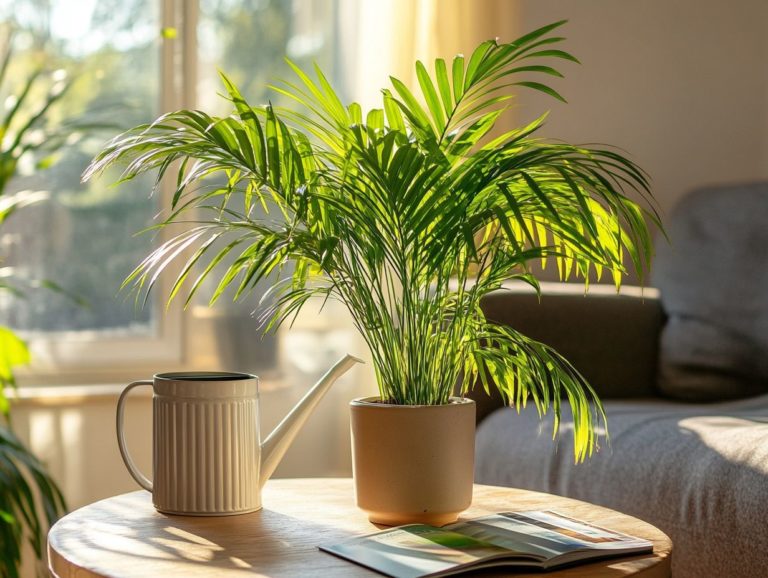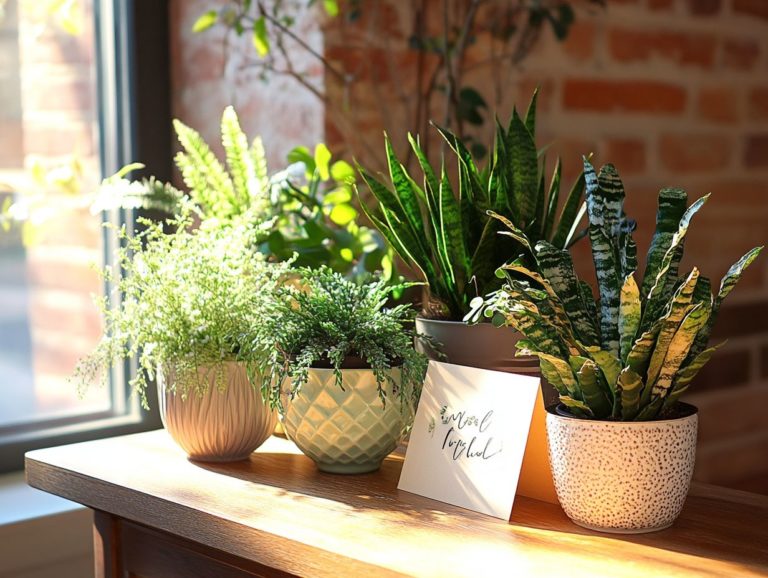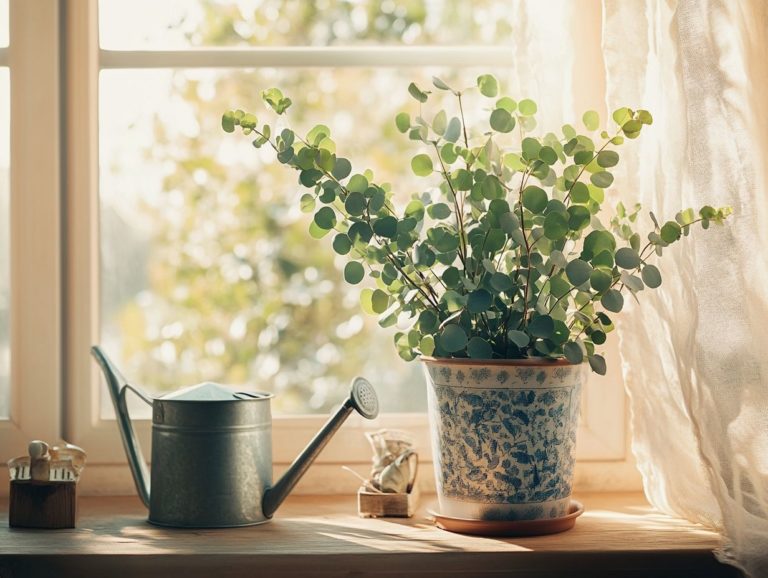How to Choose the Right Indoor Herbs
Growing indoor herbs is delightful. It elevates your cooking and brings nature into your home. These vibrant plants offer a myriad of health benefits and bring fresh flavors to your meals, all conveniently at your fingertips.
This guide will explore essential factors to consider when selecting herbs for your indoor garden. It will highlight popular varieties and their culinary uses, and provide maintenance tips to ensure your herbs thrive beautifully. Whether you re a seasoned gardener or just starting out, cultivating indoor herbs can truly transform your cooking experience and brighten your living space.
Contents
- Key Takeaways:
- Benefits of Growing Indoor Herbs
- Factors to Consider When Choosing Indoor Herbs
- Popular Herbs for Indoor Growing
- Tips for Maintaining Indoor Herb Gardens
- Frequently Asked Questions
- What are some factors to consider when choosing indoor herbs?
- What are some popular herbs that can be grown indoors, particularly in a hydroponic system?
- How much sunlight do indoor herbs need for optimal herb growth?
- What type of containers should I use for indoor herbs?
- Can I grow multiple herb types in one container?
- Are there any herbs that are difficult to grow indoors?
Key Takeaways:
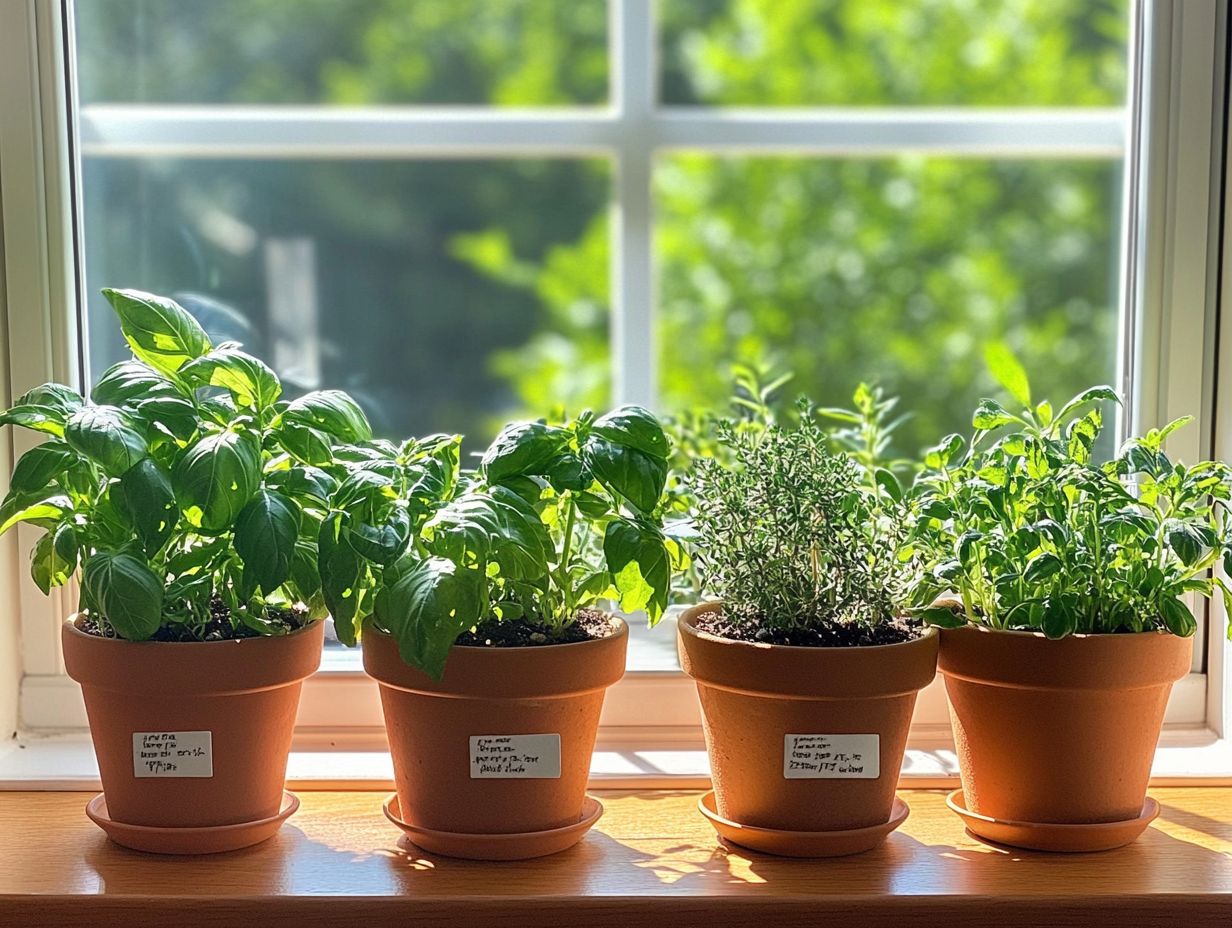
Here are some key points to remember when growing indoor herbs:
- Choose indoor herbs based on their light and temperature requirements to ensure proper growth and health.
- Consider the space and container options available to determine the best herb types for your indoor garden.
- Maintain your indoor herb garden by following proper watering and fertilizing guidelines, and learning how to handle common pests that may affect your herbs.
Benefits of Growing Indoor Herbs
Growing indoor herbs enhances your cooking and fosters a healthier lifestyle by supplying you with fresh herbs right from your kitchen.
An indoor herb garden can enhance your air quality and provide a ready supply of flavorful ingredients. It offers a rewarding hobby that encourages mindfulness and sustainability in your cooking and eating habits while contributing to a healthy lifestyle.
With easy access to herbs like basil, chives, mint, oregano, parsley, rosemary, and thyme, you can transform everyday meals into healthy and delectable experiences, enhancing your cooking with herbs.
Using quality brands like Bonnie Plants or Miracle-Gro can make herb cultivation easier and more enjoyable. This helps with effective herb maintenance and healthy growth.
Health and Practical Advantages
The health and practical advantages of incorporating fresh herbs into your diet are remarkable. They elevate the flavor of your meals and offer a wealth of health benefits.
These vibrant herbs will transform your meals into flavor-packed delights! They serve as powerful sources of vitamins, antioxidants, and essential oils. For example, basil is renowned for its anti-inflammatory properties and its potential to support heart health. Thyme is celebrated for its antimicrobial effects and its ability to strengthen your immune system. Oregano, with its impressive antioxidant content, may even assist with digestion.
What s truly delightful about these herbs is their ease of cultivation indoors. You can effortlessly grow them, ensuring that you have nutrient-rich additions to your dishes throughout the year all while embracing a healthier lifestyle.
Factors to Consider When Choosing Indoor Herbs
Selecting the perfect herbs for your indoor garden is essential and encompasses a range of considerations. Think about the types of herbs you wish to grow, their light and temperature requirements, and the unique needs of each herb variety.
By paying attention to these factors, you can cultivate a thriving indoor garden that promotes optimal plant health, ensuring a successful herb garden.
So why wait? Start your own indoor herb garden today and discover the joy of fresh herbs at your fingertips with this guide on how to grow indoor herbs successfully!
Light and Temperature Requirements
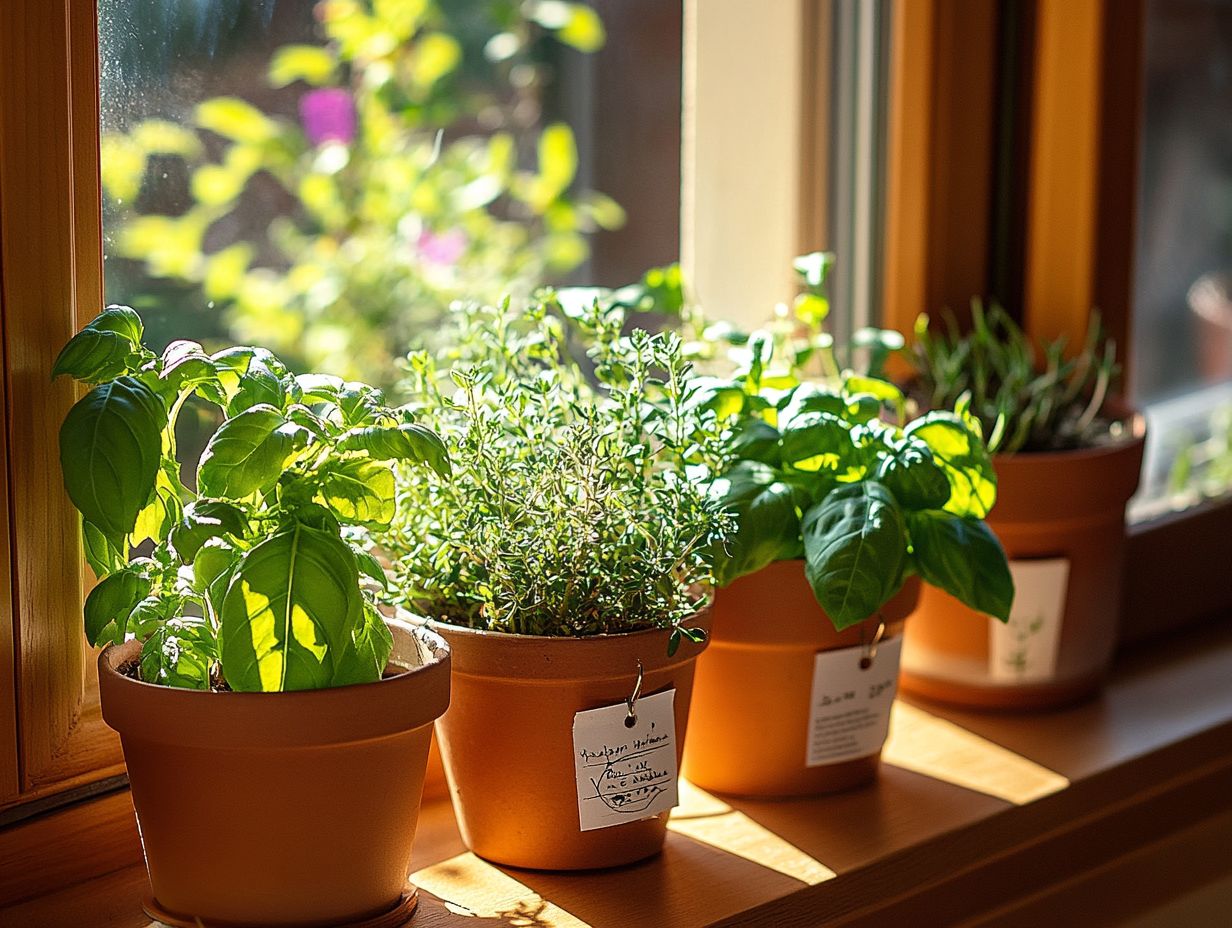
Understanding the light and temperature requirements is essential for your success in indoor herb cultivation. Herbs thrive under specific conditions, and these factors can significantly influence both their yield and health. Most herbs, like basil and rosemary, flourish when they receive bright, direct sunlight for about six to eight hours a day. On the other hand, herbs such as mint and parsley can comfortably thrive in partial shade. If you find yourself lacking sufficient natural light, get grow lights now to keep your plants happy! These can effectively mimic sunlight, promoting the vital process of photosynthesis, which is how plants make food from sunlight.
Also, keep the temperature between 65 F and 75 F for your indoor herbs. Proper air circulation is equally important, as it helps prevent mold and mildew. This ensures that your plants remain healthy and robust throughout their indoor journey.
Space and Container Options
When you re planning your indoor herb garden, taking a moment to evaluate your space and select the right container options is essential for promoting healthy growth and easy maintenance. By carefully considering both the size and type of containers, you can create an inviting and functional herb garden that seamlessly fits into your home environment.
Utilizing windowsills, shelves, or even hanging pots can maximize your space efficiency while allowing sunlight to nourish your plants. Remember to choose containers with good drainage; this prevents waterlogged roots, which can be detrimental to delicate herbs. The choice of potting soil is equally important. Opting for a well-aerated mix specifically designed for herbs will encourage robust growth and vibrant flavors. Additionally, following lighting tips for indoor herb gardens will ensure your plants receive the necessary light they need. With these thoughtful considerations in mind, you’ll be well on your way to cultivating a successful indoor herb garden.
Popular Herbs for Indoor Growing
Opting for popular herbs for indoor cultivation can transform your space into a vibrant and diverse herb garden, brimming with flavors and aromas that enhance your culinary creations and elevate the aesthetics of your kitchen.
Types of Herbs and Their Uses
Different types of herbs each serve unique culinary purposes, making them essential staples in your kitchen. From the aromatic embrace of basil to the refreshing zing of mint and the robust character of oregano, having these herbs on hand can transform your cooking. Incorporating a range of herbs like fragrant rosemary that elevates roasted meats or zesty cilantro that brightens salsas can elevate your dishes to new heights.
Growing these herbs indoors offers not only convenience but also a sustainable way to keep fresh flavors within reach. Herbs like thyme and parsley not only add depth to soups and salads but also turn tending to them into a rewarding hobby, bringing a sense of accomplishment and joy. With indoor gardening techniques at your disposal, enjoy year-round access to these vibrant ingredients while practicing effective plant care. To ensure your herbs thrive, learn how to find the right soil for your indoor plants.
Tips for Maintaining Indoor Herb Gardens
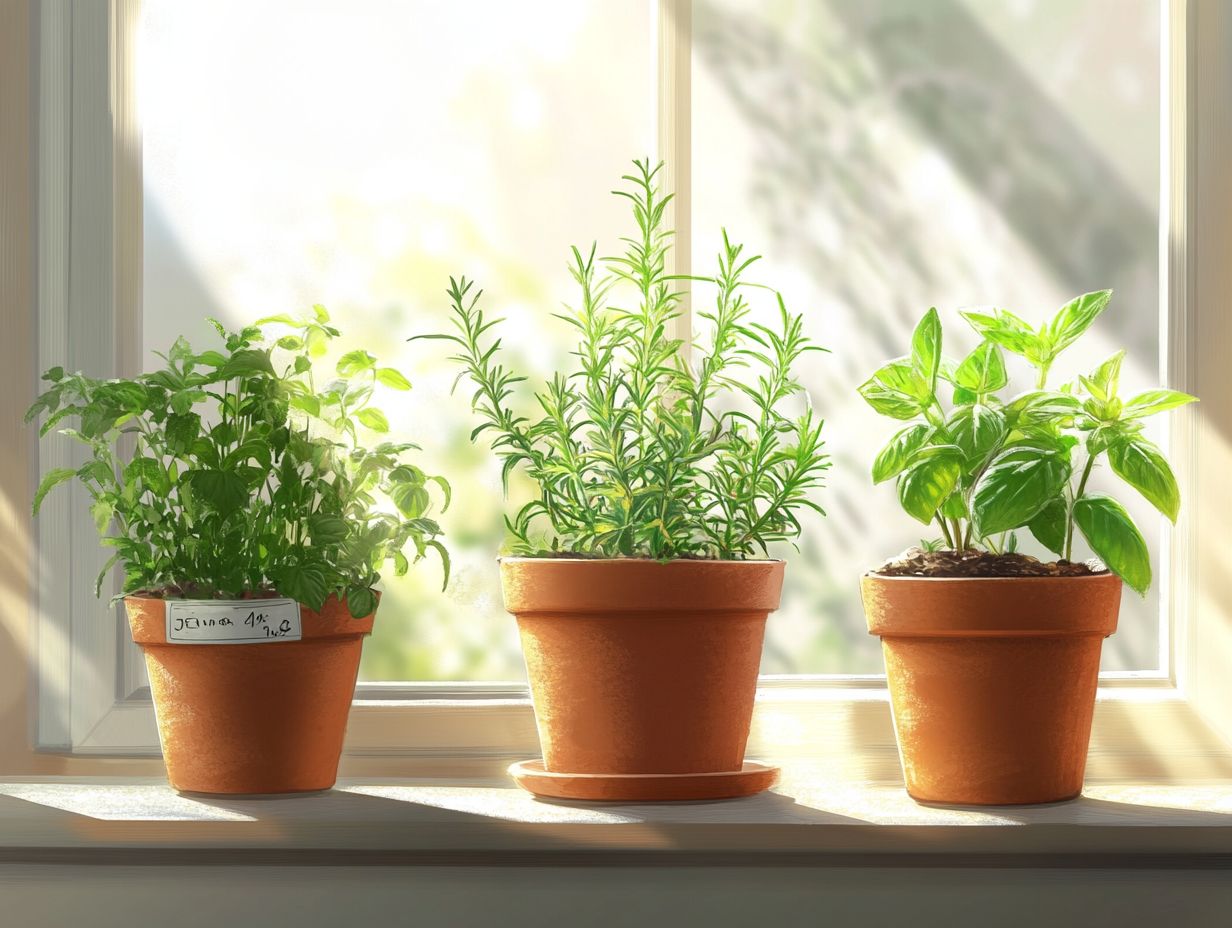
To cultivate a flourishing indoor herb garden, master proper watering to see your herbs thrive! Engaging in diligent care is essential. This includes managing humidity levels and ensuring sufficient air circulation each essential for promoting robust plant growth.
Start your indoor herb garden today and enjoy fresh flavors year-round!
Watering and Fertilizing Guidelines
Proper watering and fertilizing guidelines are essential for the health of your indoor herbs. They ensure that your plants receive the right balance of moisture and nutrients to thrive, especially through nutrient solutions.
Each herb type has specific needs that can significantly enhance their growth and flavor. For instance, herbs like basil and mint enjoy consistently moist soil. If you’re interested in learning how to propagate herbs indoors, you’ll find that in contrast, succulents and rosemary prefer a more measured approach to watering, allowing the top layer of soil to dry out between sessions.
Using techniques like bottom watering can prevent over-saturation. This method enables your plants to absorb precisely what they need. Integrating organic plant food into your watering routine can provide essential nutrients, and composting herbs offers a sustainable way to enrich the soil naturally.
Common Pests and How to Handle Them
Being aware of common pests in indoor gardening and taking effective pest control measures is vital for maintaining your herbs’ health. This ensures a bountiful harvest during your gardening efforts.
Ignoring pest management can jeopardize your plants’ vitality and create unsanitary conditions in your indoor space. Pests like aphids, spider mites, and whiteflies can drain nutrients and weaken your plants. A smart strategy is to use Safer insecticidal soap, which effectively targets soft-bodied insects while being gentle on your herbs.
Regularly inspect your plants, maintain good airflow, and ensure proper watering. These practices significantly reduce the risk of infestations. Taking a proactive approach helps safeguard your herbs and promotes a thriving indoor garden.
Frequently Asked Questions
What are some factors to consider when choosing indoor herbs?
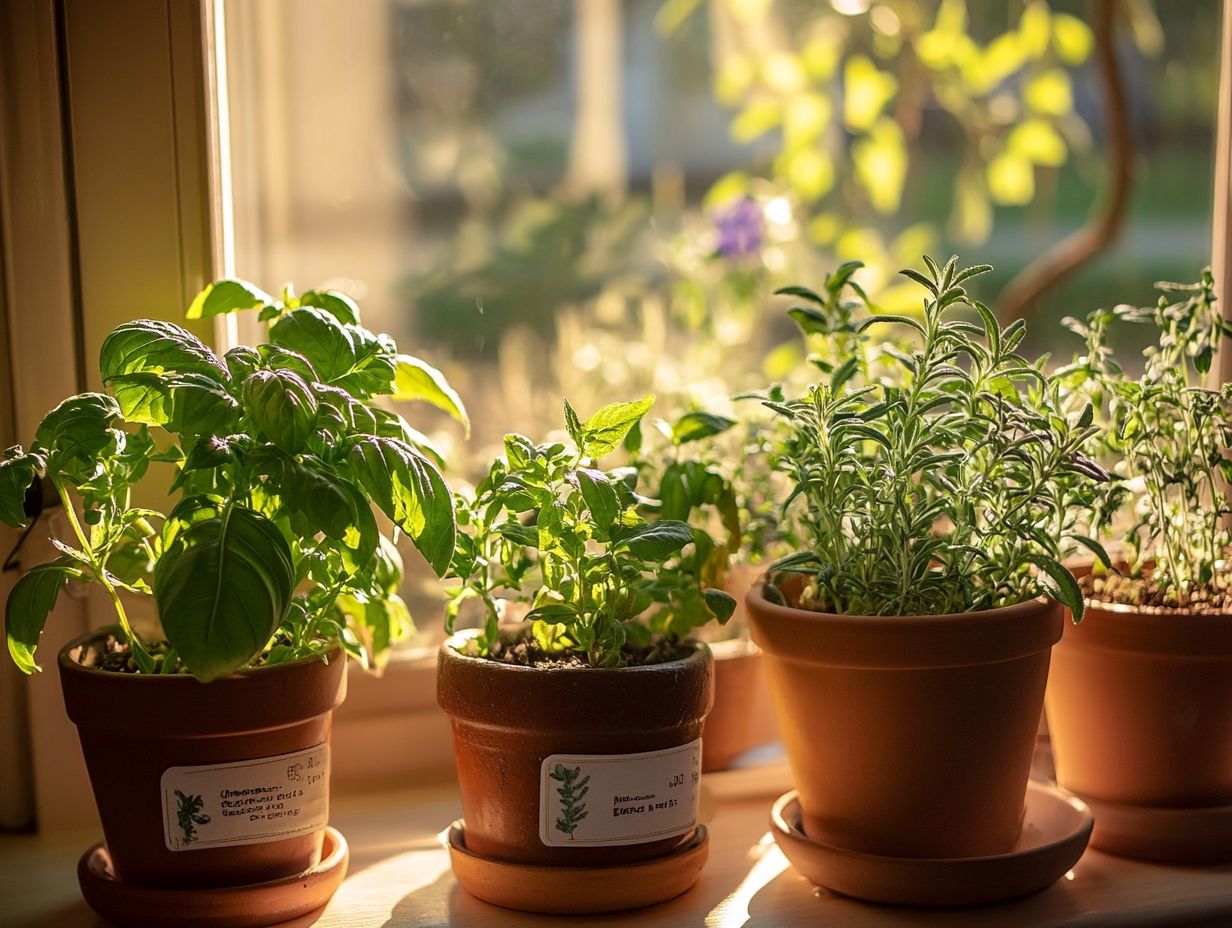
Consider your available space, the amount of sunlight, and the herbs’ water and soil requirements.
What are some popular herbs that can be grown indoors, particularly in a hydroponic system?
Popular indoor herbs include basil, rosemary, thyme, mint, parsley, and chives. They can flourish with proper attention to herb care.
How much sunlight do indoor herbs need for optimal herb growth?
Most herbs require at least 4-6 hours of sunlight daily. Ensure your chosen spot receives enough natural light, or consider investing in a grow light.
What type of containers should I use for indoor herbs?
Choose containers that are at least 6-8 inches in diameter and have proper drainage holes. Options include traditional pots, hanging baskets, or even repurposed mason jars or tin cans.
Can I grow multiple herb types in one container?
Yes, you can mix and match herbs in one container. Just ensure they have similar growing requirements and enough space. Be cautious, as some herbs, like mint, can be invasive and take over the container.
Are there any herbs that are difficult to grow indoors?
Some herbs, such as cilantro, can be challenging due to their short lifespan and specific temperature and humidity requirements. It’s best to research and start with easier herbs before attempting more difficult ones.
Explore more about herb gardening and try out different varieties to enhance your indoor gardening experience!



